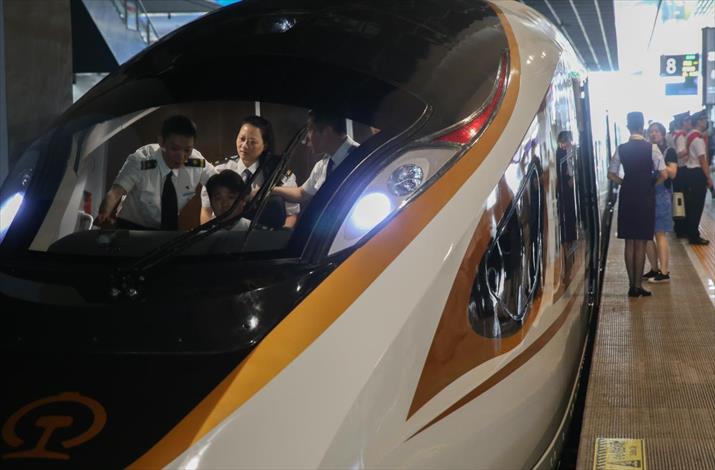|
||||||
|
||||||
| Home Nation World Business Opinion Lifestyle Multimedia Documents Special Reports Africa Travel |
|
||||||
|
||||||
| Home Nation World Business Opinion Lifestyle Multimedia Documents Special Reports Africa Travel |
| Nation |
| On the Right Track |
| Homegrown new-generation express train makes its debut |
| By Yuan Yuan | NO. 27 JULY 6, 2017 |
 Working staff prepare for the departure of the Fuxing train in Shanghai on June 26 (XINHUA)
A bullet train ready to depart from Beijing South Railway Station for Shanghai at 11:05 a.m. on June 26 was fully packed, a rare scene for a train leaving on a Monday. But many passengers chose to take the train randomly while purchasing tickets. They had no idea that they would be on the maiden trip of China's newest bullet train before getting onboard. G123 is the number of the train, looking no different from the other high-speed trains' numbers, which consist of the letter "G" and three or four digits. "I felt something must be special with this train as I saw many people taking pictures and videos of the train while I came to the platform," a passenger surnamed Du told ThePaper.cn, a Shanghai-based online news platform. "I thought a movie was being filmed here." Soon Du found out something different with the train. "It looked rather new with a red ribbon attached to the head of the train for the debut," Du said. "The color of the train is also different from the silver high-speed trains I took before. It is the combination of white and red and looks prettier."  A passenger takes a selfie with the Fuxing train at Beijing South Railway Station on June 26 (XINHUA)
The indigenous train In operation since 2008 in China, the bullet train, with super high speed and great convenience, has gradually become the major choice for passenger transportation in China. The line connecting Beijing and Shanghai is one of the busiest high-speed railways. It has largely shortened the trip from about 13 hours to around five hours. Since its inauguration in June 2011, more than 600 million passenger trips have been made on the line and now, on average, there are about 500,000 passengers traveling on it each day. But problems also propped up in the operation of these high-speed trains. On May 2, Lian Xiao, one of China's top Go players, complained that his first-class accommodation from Beijing to Hangzhou in Zhejiang Province was downgraded to second class after the original train was temporarily changed to another one of a different model that has fewer first-class seats. Lian posted his experience online and quite a few other passengers popped up with similar experiences. "At the beginning of developing high-speed trains in China, we imported four types of technology systems from Japan and Europe. Each has its own standard and is not compatible with others, so we didn't have a standard model for the high-speed trains in past years." said Wang Yueming, chief researcher at the China Academy of Railway Sciences, to Yangtze Evening News published in Nanjing, Jiangsu Province. "The trains running on the same line could be of different models and have different seat layouts." But such problems are expected to be solved with the new-generation bullet train, named Fuxing or "rejuvenation" in English, which was independently developed by China from 2012. The previous generation is known as Hexie or "harmony." "The new train models were mainly developed based on China's own railway standards and indigenous technologies, and were designed to be better adapted to China's environment and rail transport patterns," said Lu Dongfu, General Manager of the China Railway Corp., the national railway operator, at a ceremony in Beijing on June 25. Fuxing reaches a height of 4.05 meters, taller than Hexie's height of 3.7 meters, and each seat has larger legroom. The seat numbers are displayed digitally above the seat and each seat has access to a power charger, with both electrical sockets and USB ports. In Hexie trains, though, some chargers are attached to the back of the front rows, which is not as convenient. Free Wi-Fi is available onboard the new train. The lights equipped in the new train can be adjusted to different levels of brightness and each seat has a reading light that can be adjusted both automatically and manually. "It feels more spacious and comfortable," a passenger onboard the G123, surnamed Chen, told Xinhua News Agency. "And it is quieter during the trip." Another passenger surnamed Yao changed his air ticket to Shanghai to a G123 train ticket after learning the news of the Fuxing train's debut. "I feel very lucky to be in the first group of passengers on the high-speed train developed on our own," Yao told Star Daily. "I hope that in the future all the trains running on tracks in China can be self-developed." Almost at the same time of the G123 on June 26, another Fuxing train, G124, also set off from Shanghai for Beijing. But these two trains are of two different models, namely CR400AF and CR400BF respectively. CR represents China Railway and 400 means the trains can reach 400 km per hour. Despite being higher and more spacious, the energy consumption of the Fuxing train has also been greatly reduced compared to Hexie trains, according to Wang Yueming. He said the body of the Fuxing train is more streamlined than Hexie's, thus reducing air friction while running. The new train also has a sophisticated monitoring system, which is formed with more than 2,500 monitoring spots, over 500 more than the previous trains, Wang said. They can constantly check the train's performance and collect more than 1,500 types of information. The system can automatically slow the train in case of emergencies or abnormal conditions. Meanwhile, a remote data-transmission system and a control center are able to monitor the train in real time. "This train is brilliant, especially the details of the design," said Zhao Wenjia, a middle school student from Wuhu City in Anhui Province, who took the G123 on June 26. "The Wi-Fi connection is fast enough to surf the Internet with smartphones." Zhao even got a signature from the conductor on his ticket. "It is a worthwhile experience and I will keep the ticket as a memory." The chief engineer of the Fuxing train, Wang Xigang, said when he just started working at CRRC Corp., developer of the Fuxing train and the world's largest rolling-stock maker, in 1999, the running speed of China's trains was just over 100 km per hour. "At that time, the speed of 400 km per hour was like a daydream," Wang told Yangtze Evening News. "It is a challenge of comprehensive technologies. Now we can make it." Explorations The Fuxing train's debut added to the growing list of achievements of China's high-speed railway sector. On June 12, test operation on the express track connecting Baoji in Shaanxi Province and Lanzhou in Gansu Province started and in July the railway will be put into official operation. By the end of this year, with the launch of a line between Guiyang in Guizhou Province and Xi'an in Shaanxi, the five key cities in west China—Chongqing, Chengdu in Sichuan Province, Kunming in Yunnan Province, Guiyang and Xi'an—will all be linked via high-speed trains. "We have also explored technologies for running high-speed trains in various climate and geological conditions, including super cold climates in Heilongjiang Province, humid weather in Hainan Province and tunnels in the mountainous areas," said He Huawu, Chief Engineer of the China Railway Corp., during an interview with Xinhua. Since 2012, the mileage of China's high-speed railway network has expanded from less than 10,000 km to over 22,000 km, surpassing the total mileage of all other countries. A middle- and long-term rail network plan released on July 2016 said by the end of 2020, the total mileage of China's express tracks will be 30,000 km. During the Belt and Road Forum for International Cooperation in Beijing in May, a survey on students from more than 20 countries in China showed that the thing they want most to bring back to their homelands from China is the high-speed train. "Our high-speed trains can be better adapted to various geographical conditions not only in China but also in many other countries," He said. "The Fuxing train will soon be used in Indonesia's high-speed train project. The high-speed train has played an important role in promoting international cooperation." Copyedited by Dominic James Madar Comments to yuanyuan@bjreview.com |
About Us | Contact Us | Advertise with Us | Subscribe
|
||
| Copyright Beijing Review All rights reserved 京ICP备08005356号 京公网安备110102005860号 |